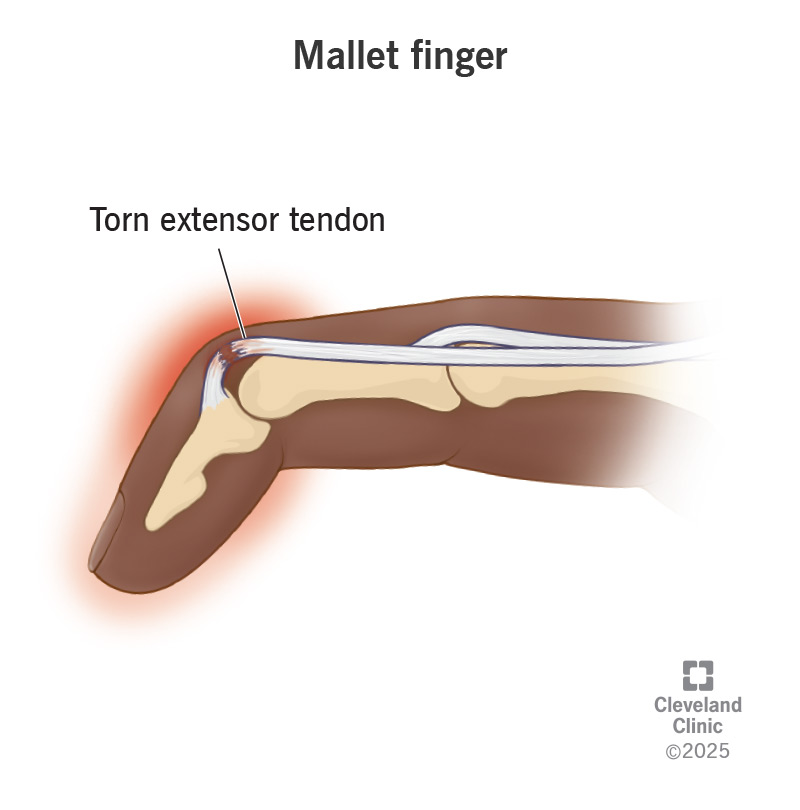Mallet finger (baseball finger) is a common injury among athletes, but anyone can get it. It happens when something hard hits the tip of your finger, or some other trauma injures the mechanism that allows you to straighten it. As a result, the tip of your finger droops downward, making it look like a mallet. A tendon injury or bone injury may cause it.
Advertisement
Cleveland Clinic is a non-profit academic medical center. Advertising on our site helps support our mission. We do not endorse non-Cleveland Clinic products or services. Policy

Mallet finger is an injury to the tip of your finger that causes it to droop downward, making your finger look like a mallet. It happens when you injure the extensor tendon that extends the tip of your finger (terminal extensor). If this tendon gets torn, cut or displaced, it won’t be able to pull your finger joint straight.
Advertisement
Cleveland Clinic is a non-profit academic medical center. Advertising on our site helps support our mission. We do not endorse non-Cleveland Clinic products or services. Policy
Mallet finger is a common sports injury, especially among baseball players. (Its other name is baseball finger.) It can happen when something hard hits your extended fingertip, like a flying ball that you’re trying to catch. You may also get it by accidentally striking your fingertip or getting it caught in a door.
The main symptom of mallet finger is that your fingertip droops and you can’t straighten it. It usually follows an injury. Your finger may be red and swollen, especially if your injury involves a fracture (broken bone). Bruising may also appear after 48 hours.
Any traumatic injury that weakens, tears, cuts or dislocates the terminal extensor tendon at the tip of your finger can cause mallet finger. Extensor tendons allow you to extend (straighten) your finger joints. If the tendon can’t pull on your fingertip, you won’t be able to straighten it. This can happen if:
Advertisement
If you don’t get treatment for mallet finger, it might be permanent. It can also lead to further deformity in your finger. The imbalance of forces on your finger joint can pull other joints out of shape, leading to a swan neck deformity. In children, a mallet finger injury may injure the growth plate of the bone and affect the long-term growth of the finger.
If you’ve injured your finger and can’t move it normally, see a healthcare provider. They’ll ask about the injury and examine your finger. Then, they’ll take images of your finger to assess the damage and determine what kind of treatment you’ll need.
Before you see a healthcare provider about your injury, you can treat it with some first aid:
Most mallet fingers won’t need surgery. But you might need surgery if you have a complicated fracture or your tendon is torn all the way through. It’s best to have your injury checked out right away so you know how serious it is. If you’re going to need surgery, it’ll be best to have it as soon as possible.
Most mallet finger injuries will heal if you wear a finger splint to keep it in the right position. You’ll wear it for at least six to eight weeks, and often longer, day and night. Your healthcare provider will show you how to clean and care for it. They might want to take some X-rays in a few weeks to check how it’s healing.
You might need surgery to repair a severed tendon or fracture, or to realign the joint and hold it in place while it heals. Surgery to repair mallet finger is an outpatient procedure. You’ll usually have local or regional anesthesia, and you can go home soon afterward. You’ll wear a splint when you go home.
Most mallet finger injuries heal with eight weeks of splinting. In more severe cases, it may take up to 16 weeks. After the splint comes off, your healthcare provider may give you finger exercises to practice at home, or they may refer you to a hand therapist. Full recovery may take a few more weeks to months.
Most fingers recover from mallet finger injuries, as long as they get treatment soon enough. After splinting and some hand therapy, you should be able to straighten your fingertip again. Sometimes, it remains a little bit bent, or there’s a bump on the underside of the joint, but it still functions normally.
Advertisement
Take care of yourself by following your treatment plan faithfully. It’s very important to wear your splint at all times, or as instructed by your healthcare provider, and only remove it for cleaning. After your splint comes off, practice your finger exercises as instructed to relieve stiffness and restore flexibility.
Mallet finger usually responds to simple treatment, but it’s important to have a healthcare provider treat it. Contact your provider if you hurt your finger and can’t move it normally. Don’t assume it isn’t serious and hesitate to seek attention. This can delay the healing process and limit your recovery.
Advertisement
If an injury puts you on the bench, you want experts by your side. Cleveland Clinic’s sports medicine specialists can get you back in the game.

Last reviewed on 02/16/2025.
Learn more about the Health Library and our editorial process.